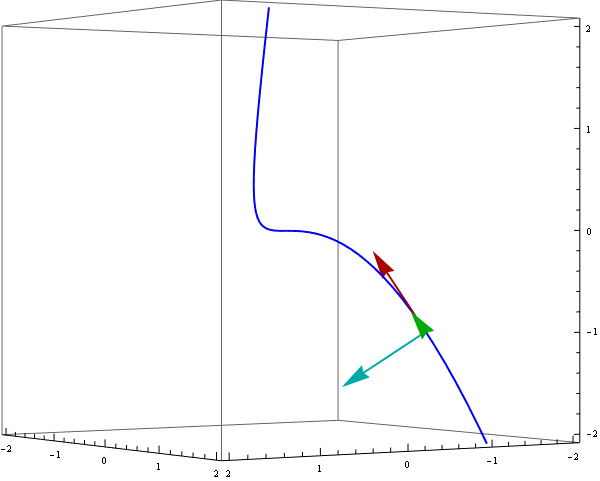For my Calc III class, I need to find $T(t), N(t)$, and $B(t)$ for $t=1, 2$, and $-1$, given $r(t)=\{t,t^2,t^3\}$.
I've got Mathematica, but I've never used it before and I'm not sure how to coerce it into solving this. (My professor told us to use a computer, as it starts getting pretty nasty around $T'(t)$. By hand, $$T(t)=\frac{1}{ \sqrt{(1+4t^2+9t^4})}\{1,2t,3t^2\}$$
I've tried defining r as stated above and using D,Norm, and CrossProduct.
However, I get a bunch of Abs in my outputs (am I missing an assumption?). Additionally, I can't seem to google up how to ask Mathematica to sub in a specific value for $t$, once I get the equations worked out properly.
Answer
Mathematica wouldn't be much helpful if one applied only formulae calculated by hand.
Here we demonstrate how to calculate the desired geometric objects with the system having a definition of the curve r[t] :
r[t_] := {t, t^2, t^3}
now we call uT the unit tangent vector to r[t]. Since we'd like it only for real parameters we add an assumption to Simplify that t is a real number. Similarly we can do it for the normal vector vN[t] and the binormal vB[t] :
uT[t_] = Simplify[ r'[t] / Norm[ r'[t] ], t ∈ Reals];
vN[t_] = Simplify[ uT'[t]/ Norm[ uT'[t]], t ∈ Reals];
vB[t_] = Simplify[ Cross[r'[t], r''[t]] / Norm[ Cross[r'[t], r''[t]] ], t ∈ Reals];
let's write down the formulae :
{uT[t], vN[t], vB[t]} // Column // TraditionalForm

Edit
Definitions provided above are clearly more useful than only to write them down. They are powerful enough to animate a moving reper along a curve r[t]. Indeed the vectors uT[t], vN[t] and vB[t] are orthogonal and normalized, e.g.
Simplify[ Norm /@ {uT[t], vN[t], vB[t]}, t ∈ Reals]
{1, 1, 1}
To demonstrate a moving reper we can use ParametricPlot3D and Arrow enclosed in Animate :
Animate[
Show[ ParametricPlot3D[ {r[t]}, {t, -1.3, 1.3}, PlotStyle -> {Blue, Thick}],
Graphics3D[{ {Thick, Darker @ Red, Arrow[{r[s], r[s] + uT[s]}]},
{Thick, Darker @ Green, Arrow[{r[s], r[s] + vB[s]}]},
{Thick, Darker @ Cyan, Arrow[{r[s], r[s] + vN[s]}]}}],
PlotRange -> {{-2, 2}, {-2, 2}, {-2, 2}}, ViewPoint -> {4, 6, 0},
ImageSize -> 600],
{s, -1, 1}]

Comments
Post a Comment